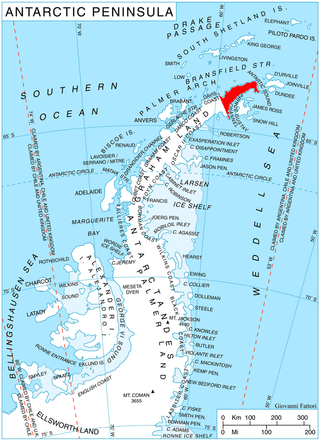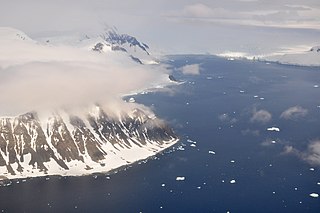
The Byrd Glacier is a major glacier in Antarctica, about 136 km (85 mi) long and 24 km (15 mi) wide. It drains an extensive area of the Antarctic plateau, and flows eastward to discharge into the Ross Ice Shelf.
The Cook Mountains is a group of mountains bounded by the Mulock and Darwin glaciers in Antarctica. They are south of the Worcester Range and north of the Darwin Mountains and the Britannia Range.

The Prince Charles Mountains are a major group of mountains in Mac. Robertson Land in Antarctica, including the Athos Range, the Porthos Range, and the Aramis Range. The highest peak is Mount Menzies, with a height of 3,228 m (10,591 ft). Other prominent peaks are Mount Izabelle and Mount Stinear. These mountains, together with other scattered peaks, form an arc about 420 km (260 mi) long, extending from the vicinity of Mount Starlight in the north to Goodspeed Nunataks in the south.
Hansen Mountains is a large group of nunataks rising to about 300 m (980 ft) above the Antarctic plateau. The mountains are approximately 89 km (55 mi) south of Stefansson Bay and they extend 40 km (25 mi) from northwest to southeast in Kemp Land, East Antarctica. The Hansen Mountains were first mapped by Norwegian cartographers from air photos taken by the 1936–1937 Lars Christensen Expedition. They were named for H.E. Hansen, the Norwegian cartographer who compiled the maps for this and other Norwegian Antarctic expeditions.
The Scott Mountains are a large number of isolated peaks lying south of Amundsen Bay in Enderby Land of East Antarctica, Antarctica. Discovered on 13 January 1930 by the British Australian New Zealand Antarctic Research Expedition (BANZARE) under Sir Douglas Mawson. He named the feature Scott Range after Captain Robert Falcon Scott, Royal Navy. The term mountains is considered more appropriate because of the isolation of its individual features.
Athos Range is the northernmost range in the Prince Charles Mountains of Mac. Robertson Land, Antarctica. The range consists of many individual mountains and nunataks that trend east–west for 40 miles (64 km) along the north side of Scylla Glacier.
The Enceladus Nunataks are a group of about eight nunataks scattered over a wide area at the head of the drainage basin of Saturn Glacier, in southern Alexander Island, Antarctica. They were mapped from trimetrogon air photography taken by the Ronne Antarctic Research Expedition, 1947–48, and from survey by the Falkland Islands Dependencies Survey, 1948–50. The group was named by the UK Antarctic Place-Names Committee from association with Saturn Glacier, Enceladus being one of the moons of the planet Saturn.
On the continent of Antarctica, the Aramis Range is the third range south in the Prince Charles Mountains, situated 11 miles southeast of the Porthos Range and extending for about 30 miles in a southwest–northeast direction. It was first visited in January 1957 by Australian National Antarctic Research Expeditions (ANARE) southern party led by W.G. Bewsher, who named it for a character in Alexandre Dumas' novel The Three Musketeers, the most popular book read on the southern journey.
Brusen Nunatak is a lone peak 3 nautical miles (6 km) west of Mount Gjeita in the Hansen Mountains. It was mapped and named by Norwegian cartographers working from air photos taken by the Lars Christensen Expedition, 1936–37.

The Camel Nunataks are two similar rock nunataks rising to 450 metres (1,480 ft), 1 nautical mile (2 km) apart, and 8 nautical miles (15 km) north of View Point and 8.68 km northwest of Garvan Point, Trinity Peninsula. The name is descriptive and has been in use amongst Falkland Islands Dependencies Survey personnel at Hope Bay since about 1959.
Voight Nunatak is a nunatak rising to about 1,500 m, 3 nautical miles (6 km) north-northwest of Tollefson Nunatak in the Yee Nunataks, Palmer Land. Mapped by United States Geological Survey (USGS) from surveys and U.S. Navy aerial photographs 1961–68. Named by Advisory Committee on Antarctic Names (US-ACAN) in 1987 after William M. Voight, USGS cartographer, who worked in the field in support of the Ross Ice Shelf Project, at Byrd and Siple Stations and at Dome Charlie in 1974–75.
Wallabies Nunataks is a large group of nunataks near the polar plateau, to the west of the Churchill Mountains, Antarctica.

Dewar Nunatak is a mainly snow-covered nunatak rising to 520 metres (1,700 ft) in the middle of Shambles Glacier, on the east coast of Adelaide Island. It was named by the UK Antarctic Place-Names Committee in 1963 for Graham J.A. Dewar, a British Antarctic Survey geologist at Adelaide station, 1961–63.
Papanin Nunataks is a small group of nunataks lying 11 nautical miles (20 km) east of Alderdice Peak in the Nye Mountains, Enderby Land. Named by the Soviet Antarctic Expedition (1961–62) for Soviet polar expert Admiral Ivan D. Papanin.
The Dwyer Nunataks are a scattered group of low peaks and ridges about 6 nautical miles (11 km) long and 3 nautical miles (6 km) wide, lying 2 nautical miles (4 km) southeast of Mount Gjeita in the Hansen Mountains of Antarctica. They were plotted from Australian National Antarctic Research Expeditions air photos and were named by the Antarctic Names Committee of Australia after V. Dwyer, a radio officer at Mawson Station in 1964, and a member of one of the survey parties which carried out a tellurometer traverse passing through the Hansen Mountains in 1965.

Fisher Nunatak is a nunatak with rock exposure, standing 13 nautical miles (24 km) west of Mount Crawford of the Sentinel Range, in the Ellsworth Mountains of Antarctica. It was discovered by the Marie Byrd Land Traverse party, 1957–58, under Charles R. Bentley, and was named for Diana D. Fisher, director, Glaciological Headquarters, of the United States – International Geophysical Year Program, 1956–59.
The Haslam Heights are a line of peaks trending north-northeast–south-southwest, rising to about 1,000 metres (3,300 ft) to the west of Vallot Glacier and Nye Glacier in Arrowsmith Peninsula, Graham Land, Antarctica. They were probably first seen by the French Antarctic Expedition, 1908–10 under Jean-Baptiste Charcot, which roughly charted the area in 1909. They were roughly mapped by the Falkland Islands Dependencies Survey (FIDS) in 1948, and named in 1985 by the UK Antarctic Place-Names Committee (UK-APC) after Rear Admiral Sir David W. Haslam, Hydrographer of the Navy, 1975–85.
Higgins Nunatak is the largest of the Samuel Nunataks, lying near the south end of this group in the Heritage Range in Antarctica. It was mapped by the United States Geological Survey from surveys and U.S. Navy air photos, 1961–66, and was named by the Advisory Committee on Antarctic Names for utilitiesman John C. Higgins, U.S. Navy, a member of the McMurdo Station party during Operation Deep Freeze 1966.
Lincoln Nunatak is a snow-capped nunatak with a rocky west face, at the end of a ridge running westward from Mount Mangin on Adelaide Island, Antarctica. It was named by the UK Antarctic Place-Names Committee for Flight Lieutenant Warren D. Lincoln, Royal Air Force, a pilot with the British Antarctic Survey Aviation Unit based at Adelaide Station in 1962–63.




